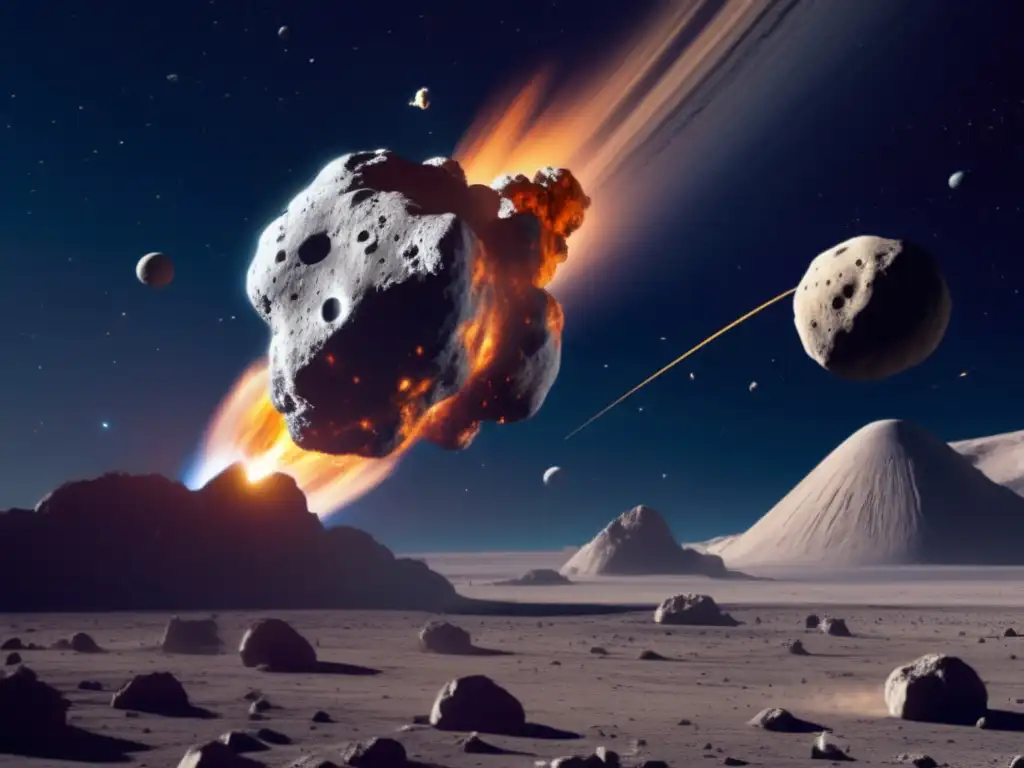The Sky Is Not Falling: How We Defend Against Asteroids

Introduction
Asteroids are fascinating celestial objects that have captured our imagination for centuries. They are often perceived as dangerous, capable of causing catastrophic events if they collide with Earth. While it's true that some asteroids can pose a threat to our planet, we have developed an impressive array of techniques to detect and defend against these potential hazards. In this article, we'll explore the various methods used to protect ourselves from asteroids and learn more about the science behind planetary defense.
Early Detection

The Role of Telescopes
One of the most effective ways to defend against asteroids is to detect them early before they become a threat. This is where telescopes come in. Astronomers use ground-based telescopes to search the sky for potentially hazardous asteroids. These telescopes can detect asteroids hundreds of millions of kilometers away, giving us ample time to plan and execute a defense strategy.
The Importance of Space-Based Observatories
In addition to ground-based telescopes, we also rely on space-based observatories to detect asteroids. These observatories are located outside of Earth's atmosphere, which allows them to observe the sky without interference from the planet's atmosphere. They are particularly useful for detecting smaller asteroids, which can be difficult to spot from the ground. NASA's NEO (Near-Earth Object) program relies heavily on space-based observatories such as the Wide-field Infrared Survey Explorer (WISE) and the NEOWISE spacecraft.
The Need for International Collaboration
Detecting and tracking potentially hazardous asteroids requires international cooperation and collaboration. Many countries have their own asteroid detection programs, but they also work together through organizations such as the International Asteroid Warning Network (IAWN) and the Space Mission Planning Advisory Group (SMPAG). These organizations facilitate communication and collaboration between countries and help ensure that everyone is working together effectively to detect and defend against potential asteroid threats.
Deflection Strategies

Kinetic Impactors
If an asteroid is detected early enough, there are several strategies that can be employed to deflect it from its course. One of the most effective methods is to use a kinetic impactor. This involves slamming a spacecraft into the asteroid at high speed to change its trajectory. The idea is that the impact will transfer momentum from the spacecraft to the asteroid, altering its path enough to avoid a collision with Earth. The DART (Double Asteroid Redirection Test) mission, scheduled for launch in 2021, will test the effectiveness of this approach by slamming a spacecraft into a small asteroid called Didymos.
Gravity Tractors
Another deflection strategy involves using the gravitational pull of a spacecraft to alter the course of an asteroid. A spacecraft would be placed near the asteroid, and its gravitational pull would slowly and gradually alter the asteroid's trajectory. This method is particularly useful for larger asteroids that are too massive to be deflected by a kinetic impactor alone. NASA's Asteroid Redirect Mission, which was cancelled in 2017, would have tested this method by capturing a boulder from a larger asteroid and redirecting its orbit using a robotic spacecraft.
Solar Sails
Solar sails use the pressure of sunlight to alter an asteroid's course. These sails are made of lightweight, reflective material that captures the energy of the sun's photons, generating a small but steady force. Over time, this force can accumulate and alter an asteroid's trajectory. While this method is less proven than kinetic impactors or gravity tractors, it has the advantage of being relatively low-cost and scalable.
Common Misconceptions

Myth: Asteroid Collisions Are Inevitable
While it's true that some asteroids may eventually collide with Earth, it's important to remember that these events are rare and largely preventable. By detecting asteroids early and employing effective deflection strategies, we can greatly reduce the risk of a catastrophic collision.
Myth: Deflecting Asteroids is Impossible
While the science of asteroid deflection is still evolving, we have already developed several effective strategies for altering their trajectories. With continued research and innovation, we may discover even more effective methods in the future.
Frequently Asked Questions

-
Can we predict when an asteroid will hit Earth?
We can make predictions based on an asteroid's trajectory and other factors, but it's impossible to predict with 100% accuracy.
-
How likely is it that an asteroid will hit Earth?
The chances of a catastrophic asteroid collision are relatively low, but the consequences could be severe. It's important to remain vigilant and prepared.
-
What happens if an asteroid does collide with Earth?
Depending on the size and location of the impact, an asteroid collision could cause widespread damage and loss of life.
-
Why is international collaboration important for asteroid detection and defense?
Asteroids pose a global threat, and it's essential that countries work together to detect and deflect potential threats.
-
What can I do to help with asteroid defense?
There are several ways you can get involved, from supporting organizations such as the Planetary Society to advocating for increased government funding for asteroid detection and defense.
Conclusion
Asteroids may seem like an ominous threat, but with early detection and effective deflection strategies, we can greatly reduce the risk of a catastrophic collision. Advances in technology and international collaboration continue to improve our ability to detect and defend against these potential hazards. We must remain vigilant and prepared, but we should also feel confident in our ability to protect ourselves from the sky's falling objects.
We hope this article has provided valuable insights into the science of planetary defense and the various strategies employed to safeguard our planet from asteroid threats. If you have any questions or comments, please share them in the comments section below.
Additional Resources

- NASA's Center for Near-Earth Object Studies
- The Planetary Society
- Asteroid News and Information from Space.com
 Earth’s Defenses: Current Measures Against Asteroid Impacts
Earth’s Defenses: Current Measures Against Asteroid Impacts Watchmen Of The Cosmos: Current Strategies In Asteroid Defense
Watchmen Of The Cosmos: Current Strategies In Asteroid Defense Planetary Preservation: How We Prevent Asteroid Impacts
Planetary Preservation: How We Prevent Asteroid ImpactsIf you want to discover more articles similar to The Sky Is Not Falling: How We Defend Against Asteroids, you can visit the Planetary Defense category.
Leave a Reply

Articulos relacionados: